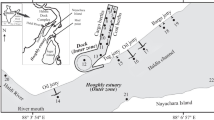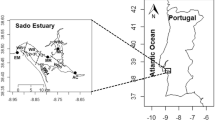Abstract
A comprehensive study on the phytoplankton standing stocks, species composition and dominant species in the eutrophic Changjiang (Yangtze River) Estuary (CE) was conducted to reveal the response of phytoplankton assemblage to Changjiang Diluted Water (CDW) and upwelling in the spring. Phytoplankton presented peak standing stocks (13.03 μg/L of chlorophyll a, 984.5×103 cells/L of phytoplankton abundance) along the surface isohaline of 25. Sixty-six species in 41 genera of Bacillariophyta and 33 species in 19 genera of Pyrrophyta were identified, as well as 5 species in Chlorophyta and Chrysophyta. Karenia mikimotoi was the most dominant species, followed by Prorocentrum dentatum, Paralia sulcata, Pseudo-nitzschia delicatissima and Skeletonema costatum. A bloom of K. mikimotoi was observed in the stratified stations, where the water was characterized by low nitrate, low phosphate, low turbidity, and specific ranges of temperature (18–22 °C) and salinity (27–32). K. mikimotoi and P. dentatum accumulated densely in the upper layers along the isohaline of 25. S. costatum was distributed in the west of the isohaline of 20. Benthonic P. sulcata presented high abundance near the bottom, while spread upward at upwelling stations. CDW resulted in overt gradients of salinity, turbidity and nutritional condition, determining the spatial distribution of phytoplankton species. The restricted upwelling resulted in the upward transport of P. sulcata and exclusion of S. costatum, K. mikimotoi and P. dentatum. The results suggested that CDW and upwelling were of importance in regulating the structure and distribution of phytoplankton assemblage in the CE and the East China Sea.
Similar content being viewed by others
References
Blasco D, Estrada M, Jones B. 1980. Relationship between the phytoplankton distribution and composition and the hydrography in the northwest African upwelling region near Cabo Corbeiro. Deep-Sea Res Part I, 27A(10): 799–821
Chai Chao, Yu Zhiming, Song Xiuxian, et al. 2006. The status and characteristics of eutrophication in the Yangtze River (Changjiang) Estuary and the adjacent East China Sea, China. Hydrobiologia, 563(1): 313–328
Chen Hanlin, Lv Songhui, Zhang Chuansong, et al. 2006. A survey on the red tide of Prorocentrum donghaiense in East China Sea, 2004. Ecol Sci (in Chinese), 25(3): 226–230
Chen Bingzhang, Wang Zongling, Zhu Mingyuan, et al. 2005. Effects of temperature and salinity on growth of Prorocentrum dentatum and comparisons between growths of Prorocentrum dentatum and Skeletonema costatum. Adv Mar Sci (in Chinese), 23(1): 60–64
Cui Anqing, Street R L. 2004. Large-eddy simulation of coastal upwelling flow. Environ Fluid Mech, 4(2): 197–223
Egge J K. 1998. Are diatoms poor competitors at low phosphate concentrations?. J Mar Syst, 16(3-4): 191–198
Estrada M, Berdalet E. 1998. Phytoplankton in a turbulent world. Sci Mar, 61(S1): 125–140
Gentien P, Lunven M, Lazure P, et al. 2007. Motility and autotoxicity in Karenia mikimotoi (Dinophyceae). Philos Trans R Soc Lond B Biol Sci, 362(1487): 1937–1946
Gong G C, Wen Y H, Wang B W, et al. 2003. Seasonal variation of chlorophyll a concentration, primary production and environmental conditions in the subtropical East China Sea. Deep-Sea Res Part II, 50(6-7): 1219–1236
He Qing, Sun Jun, Luan Qingshan, et al. 2007. Phytoplankton assemblage in Yangtze River Estuary and its adjacent waters in winter time. Chin J Appl Ecol (in Chinese), 18(11): 2559–2566
Li Maotian, Xu Kaiqin, Watanabe M, et al. 2007. Long-term variations in dissolved silicate, nitrogen, and phosphorus flux from the Yangtze River into the East China Sea and impacts on estuarine ecosystem. Estuar Coast Shelf Sci, 71(1-2): 3–12
Li Jiufa, Zhang Chen. 1998. Sediment resuspension and implications for turbidity maximum in the Changjiang Estuary. Mar Geol, 148(3-4): 117–124
Li Daoji, Zhang Jing, Huang Daji, et al. 2002. Oxygen depletion off the Changjiang (Yangtze River) Estuary. Sci China Ser D, 45(12): 1137–1146
Li Jintao, Zhao Weihong, Yang Dengfeng, et al. 2005. Effect of turbid water in Changjiang (Yangtze) Estuary on the growth of Skeletonema costatum. Mar Sci (in Chinese), 29(1): 34–37
Lie H J, Cho C H, Lee J H, et al. 2003. Structure and eastward extension of the Changjiang River plume in the East China Sea. J Geophys Res, 108(C3): 3077
Long Hua, Du Qi. 2005. Primary research on Karenia mikimotoi bloom in Fujian coast. J Fujian Fish (in Chinese), (107): 22–25
Luan Qingshan, Sun Jun, Song Shuqun, et al. 2007. Canonical correspondence analysis of summer phytoplankton community and its environment in the Yangtze River Estuary, China. J Plant Ecol (in Chinese), 31(3): 445–450
Luan Qingshan, Sun Jun, Song Shuqun, et al. 2008. Phytoplankton assemblage in Changjiang Estuary and its adjacent waters in autumn, 2004. Adv Mar Sci (in Chinese), 26(3): 364–371
Margalef R. 1978a. Phytoplankton communities in upwelling areas: the example of NW Africa. Oecol Aquat, 3: 97–132
Margalef R. 1978b. Life-forms of phytoplankton as survival alternatives in an unstable environment. Oceanol Acta, 1(4): 493–509
Ning Xiuren, Shi Junxian, Cai Yuming, et al. 2004. Biological productivity front in the Changjiang Estuary and the Hangzhou Bay and its ecological effects. Acta Oceanol Sin (in Chinese), 26(6): 96–106
Pei Shaofeng, Shen Zhiliang, Laws E A. 2009. Nutrient dynamics in the upwelling area of Changjiang (Yangtze River) estuary. J Coast Res, 25(3): 569–580
Pu Xinming, Wu Yulin, Zhang Yongshan. 2001. Nutrient limitation of phytoplankton in the Changjiang Estuary II. Condition of nutrient limitation in spring. Acta Oceanol Sin (in Chinese), 23(3): 57–65
Shen Zhiliang. 1991. A study on the effects of the Three Gorge Project on the distributions and changes of the nutrients in the Changjiang River estuary. Oceanol Limnol Sin (in Chinese), 22(6): 540–546
Shen Li, Xu Huiping, Guo Xulin, et al. 2011. Characteristics of largescale harmful algal blooms (HABs) in the Yangtze River estuary and the adjacent East China Sea (ECS) from 2000 to 2010. J Environ Prot, 2(10): 1285–1294
Smayda T J. 1997. Harmful algal blooms: their ecophysiology and general relevance to phytoplankton blooms in the sea. Limnol Oceanogr, 42: 1137–1153
Strickland J D H, Parsons T R. 1972. A Practical Handbook of Seawater Analysis. Ottawa: Fisheries Research Board of Canada, 167: 201–206
Tang Danling, Di Baoping, Wei Guifeng, et al. 2006. Spatial, seasonal and species variations of harmful algal blooms in the South Yellow Sea and East China Sea. Hydrobiologia, 568(1): 245–253
Tomas C R. 1997. Identifying Marine Phytoplankton. New York: Academic Press, 1–858
Utermöhl H. 1958. Zur Vervolkommung der quantitativen Phytoplankton-Methodik. Mitt Int Ver Theor Angew Limnol (in German), 9:1–38
Wang Jinhui. 2002. Phytoplankton communities in three distinct ecotypes of the Changjiang Estuary. J Ocean Univ Qingdao (in Chinese), 32(3): 422–428
Wang Jinhui, Huang Xiuqing. 2003. Ecological characteristics of Prorocentrum dentatum and the cause of harmful algal bloom formation in China Sea. Chin J Appl Ecol (in Chinese), 14(7): 1065–1069
Wei Hao, He Yunchang, Li Qingji, et al. 2007. Summer hypoxia adjacent to the Changjiang Estuary. J Mar Syst, 67(3-4): 292–303
Zhang Jing, Liu Sumei, Ren Jingling, et al. 2007. Nutrient gradients from the eutrophic Changjiang (Yangtze River) Estuary to the oligotrophic Kuroshio waters and re-evaluation of budgets for the East China Sea Shelf. Prog Oceanogr, 74(4): 449–478
Zhao Baoren. 1993. Upwelling phenomenon off the Changjiang Estuary. Haiyang Xuebao (in Chinese), 15(2): 108–114
Zhao Baoren, Ren Guangfa, Cao Deming, et al. 2001. Characteristics of the ecological environment in upwelling area adjacent to the Changjiang River estuary. Oceanol Limnol Sin (in Chinese), 32(3): 327–333
Zhao Ran, Sun Jun, Song Shuqun. 2013. Phytoplankton in the Yangtze River Estuary and its adjacent waters in spring 2006. Mar Sci Bull (in Chinese), 32(4): 421–428
Zhou Mingjiang, Shen Zhiliang, Yu Rencheng. 2008. Responses of a coastal phytoplankton community to increased nutrient input from the Changjiang (Yangtze) River. Cont Shelf Res, 28(12): 1483–1489
Zhu Zhuoyi, Zhang Jing, Wu Ying, et al. 2011. Hypoxia off the Changjiang (Yangtze River) Estuary: oxygen depletion and organic matter decomposition. Mar Chem, 125(1-4): 108–116
Acknowledgements
The authors thank the colleagues from Key Laboratory of Marine Ecology and Environmental Sciences for their assistance in field and laboratory work.
Author information
Authors and Affiliations
Corresponding author
Additional information
Foundation item: The National Natural Science Foundation of China-Shandong Joint Fund for Marine Science Research Centers under contract No. U1606404; the Youth Project of Natural Science Foundation of Shandong Province under contract No. ZR2014DQ029; the Youth Project of National Natural Science Foundation of China under contract No. 41606128; the Scientific and Technological Innovation Project of Qingdao National Laboratory for Marine Science and Technology under contract Nos 2016ASKJ02 and 2015ASKJ02; the Aoshan Talents Program of Qingdao National Laboratory for Marine Science and Technology under contract No. 2015ASTP.
Rights and permissions
About this article
Cite this article
Song, S., Li, Z., Li, C. et al. The response of spring phytoplankton assemblage to diluted water and upwelling in the eutrophic Changjiang (Yangtze River) Estuary. Acta Oceanol. Sin. 36, 101–110 (2017). https://doi.org/10.1007/s13131-017-1094-z
Received:
Accepted:
Published:
Issue Date:
DOI: https://doi.org/10.1007/s13131-017-1094-z




